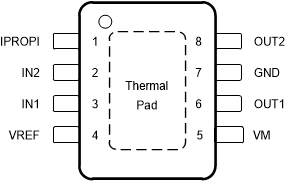ZHCSPH2 January 2022 DRV8251A
PRODUCTION DATA
- 1 特性
- 2 应用
- 3 说明
- 4 Revision History
- 5 Device Comparison
- 6 Pin Configuration and Functions
- 7 Specifications
- 8 Detailed Description
- 9 Application and Implementation
- 10Power Supply Recommendations
- 11Layout
- 12Device and Documentation Support
- 13Mechanical, Packaging, and Orderable Information
6 Pin Configuration and Functions
 Figure 6-1 DDA Package8-Pin HSOPTop View
Figure 6-1 DDA Package8-Pin HSOPTop ViewTable 6-1 Pin Functions
| PIN | TYPE | DESCRIPTION | ||
|---|---|---|---|---|
| NAME | NO. | |||
| GND | 7 | PWR | Device power ground. Connect to system ground. | |
| IN1 | 3 | I | Logic inputs. Controls the H-bridge output. Has internal pulldowns. See Table 8-2. | |
| IN2 | 2 | I | Logic inputs. Controls the H-bridge output. Has internal pulldowns. See Table 8-2. | |
| IPROPI | 1 | PWR | Analog current output proportional to load current. Section 8.4.2.1. | |
| OUT1 | 6 | O | H-bridge output. Connect directly to the motor or other inductive load. | |
| OUT2 | 8 | O | H-bridge output. Connect directly to the motor or other inductive load. | |
| VM | 5 | PWR | 4.5-V to 48-V power supply. Connect a 0.1-µF bypass capacitor to ground, as well as sufficient bulk capacitance, rated for the VM voltage. | |
| VREF | 4 | I | Analog input. Apply a voltage between 0 to 5 V. For information on current regulation, see the Section 8.4.2.1 section. | |
| PAD | — | Thermal pad. Connect to board ground. For good thermal dissipation, use large ground planes on multiple layers, and multiple nearby vias connecting those planes. | ||